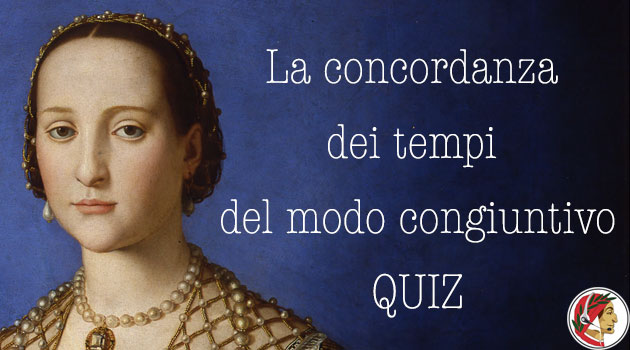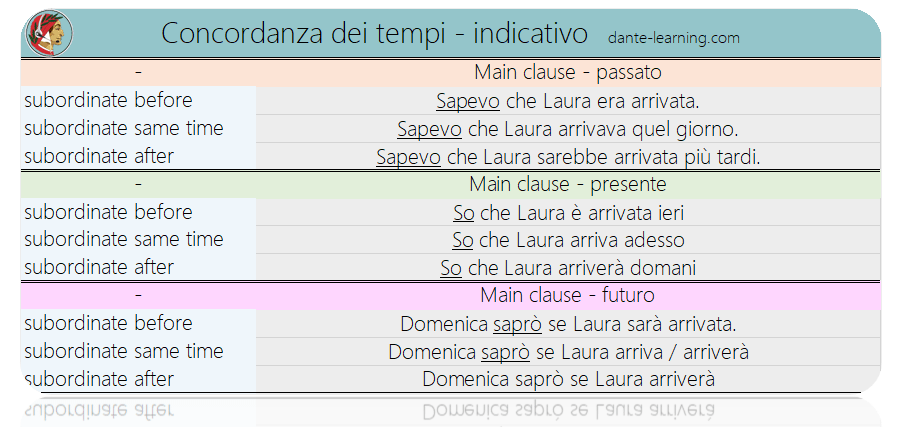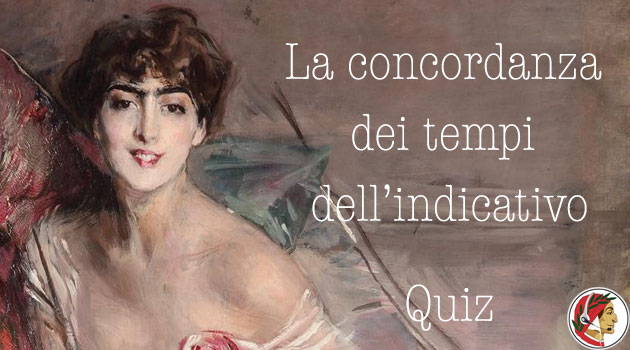Impara la concordanza dei tempi del modo congiuntivo.
Con un quiz
Una qualsiasi frase principale (reggente) in italiano, come in altre lingue, può cominciare con un verbo al presente, al passato, al futuro.
I verbi della frase dipendente (subordinata) con il congiuntivo hanno una relazione nel tempo con la frase principale.
Possono descrivere una azione anteriore (che avviene prima), contemporanea (nello stesso momento) o posteriore (dopo) rispetto alla frase principale.
Questo concetto è valido sia per l’indicativo che per il congiuntivo.
- So che Mario è tornato a casa. (indicativo)
- Penso che Mario sia tornato a casa. (congiuntivo)
So e Penso sono due verbi della frase principale, al presente, per esempio oggi. L’azione di Mario che torna a casa è antecedente, per esempio ieri.
Oggi ci occuperemo esclusivamente del congiuntivo. Ecco uno schema riassuntivo di tutte le combinazioni possibili.
Azione principale al presente.
Penso / che Mario…
(prima)
- …sia tornato
- …tornasse
- …stesse tornando
(durante)
- …torni
- …stia tornando
(dopo)
- …torni
- …tornerà
Azione principale al passato.
Pensavo / Ho pensato / Pensai / Avevo pensato / che Mario…
(prima)
- …fosse tornato
(durante)
- …tornasse
- …stesse tornando
(dopo)
- …sarebbe tornato (futuro nel passato)
- …tornasse (contiguità)
Azione principale al futuro.
Penserò / che Mario…
(prima)
- …sia tornato
- …sarà tornato
(durante)
- …torni
- …tornerà
(dopo)
- …torni
- …tornerà
Alcune precisazioni.
Come regola generale, sappiamo che il congiuntivo di solito non si usa quando il soggetto delle due frasi è lo stesso. Per esempio:
Mario pensa che lui sia simpatico.- Mario pensa di essere simpatico.
Non è sempre così. Per esempio:
- Nonostante fossimo usciti tardi, siamo arrivati in tempo.
-+-+-+-
È possibile che il primo verbo sia al condizionale. In questo caso, la prassi vuole che la combinazione sia con il congiuntivo imperfetto o trapassato.
- Vorrei che Mario venisse / fosse venuto con me.
- Avrei voluto che Mario venisse / fosse venuto con me.
E’ una regola piuttosto debole che vale solo per alcuni verbi. Possiamo usare il congiuntivo presente anche con il condizionale.
- Immaginerei che tu adesso
fossisia stanco.
Se volete approfondire questo punto, possiamo parlarne a lezione.
-+-+-+-+-
Il caso della frase reggente al futuro è piuttosto raro. Si preferisce usare l’indicativo futuro, ma se il verbo richiede il congiuntivo lo si dovrebbe usare.
-+-+-+-
Il caso della reggente al passato prossimo può indicare un passato con “un piede nel presente”.
- Non abbiamo capito perché Luigi si sia arrabbiato.
La frase è corretta perché “continuiamo a non capire” anche nel presente.
Decidere l’esatta concordanza del modo congiuntivo non sta solo nella scelta dei tempi, ma anche nelle situazioni che lo introducono: un’emozione, un’opinione, un pensiero, un desiderio, una situazione emotiva, un’eccezione, una condizione…
La scelta del tempo giusto può superare la rigidità degli schemi che trovate sui libri.
Facciamo un po’ di pratica con il prossimo quiz. Attenzione! Per alcune frasi esistono più soluzioni possibili.
- 1
- 2
- 3
- Answered
- Review
-
1. Question
La concordanza dei Tempi
del Modo Congiuntivo
Frase principale al presente
Mi pare che Fabio (andare) sia andato via cinque minuti fa.
-
- Speriamo che adesso (smettere) di piovere.
- E' possibile che Luigi (dimenticarsi) dell'appuntamento di ieri.
- Aspettiamo tutti che voi (sposarsi) .
- Dubitiamo che domani noi (potere) vincere la partita
- Siamo contenti che tua sorella (capire) la situazione.
- Può darsi che adesso i tuoi amici (finire) già di mangiare.
- Credo che (essere) meglio aspettare che il temporale (finire) . Poi partiremo.
- E' probabile che mio figlio (svegliarsi) appena adesso.
- Non è carino che ieri lui (andarsene) senza salutare.
-
Grazie e alla prossima.
Opera d’arte: Agnolo Bronzino – Ritratto di Eleonora di toledo con il figlio Giovanni – 1544



